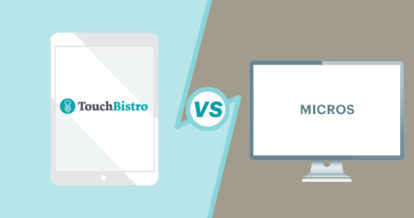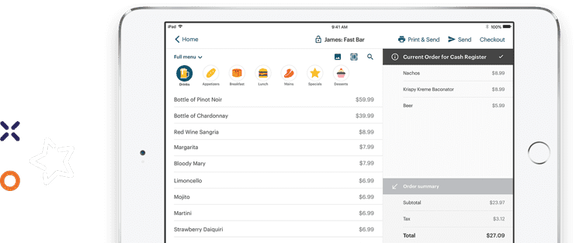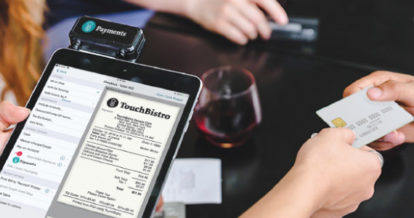| Don’t have time to read the full article? Here are the highlights |
| TouchBistro: – All-in-one POS and restaurant management system designed exclusively for restaurants – Runs on iOS and Apple iPad tablets – A cloud-based POS system with a built-in offline mode – Integrated payments with competitive pricing and the backing of a trusted institution – Extensive in-house solutions, including integrated inventory management, staff scheduling, online ordering, reservations, and more – Best for single and multi-location restaurants that are growing and scaling MICROS POS: – Legacy POS system with a lengthy and complicated setup process – Runs on Windows operating system and proprietary hardware – Robust, enterprise POS features and add-on solutions – Expensive system with high hardware, software, and maintenance costs – Best for global hospitality brands, such as international restaurant chains and franchises |
If you’re making the tough decision of choosing between a modern restaurant POS system and a legacy one, you’ve probably compared TouchBistro vs MICROS POS.
While both TouchBistro and MICROS (formally known as the Oracle MICROS Simphony POS system) are popular options for restaurants around the world, the two systems couldn’t be more different.
MICROS is a legacy POS system that has been around for decades and is now owned by the multinational technology corporation Oracle. In more recent years, the system has been updated to include cloud capabilities, and is now a popular choice for well established, global restaurant chains like Outback Steakhouse, Quiznos, and McDonald’s, as well as other venue types such as stadiums, hotels, airports, cruise ships, and more.
In contrast, TouchBistro was the very first company to launch an iPad-based restaurant POS and has been a leader in the restaurant technology space for more than a decade. Today, TouchBistro is the POS of choice for thousands of single and multi-location restaurants.
With two very different systems to compare, understanding the difference between systems like TouchBistro and MICROS can help you pinpoint the best solution for your specific business.
To help you wrap your head around the differences between these POS providers,, we’ve put together a head-to-head comparison of TouchBistro vs MICROS. Based on current product information and detailed online reviews, we’ll cover:
- The foundations of each system
- Core POS features
- Hardware
- Payments
- Other add-on solutions
- Integration partners
- Pricing
- Customer support
With the information in this guide, you’ll not only get the inside scoop on TouchBistro vs MICROS POS, but you’ll also learn what to look for (and what to avoid) when shopping for a new restaurant POS system.
If you want to compare more POS providers, you can also check out our Ultimate Guide to the Best Restaurant POS Systems.
The information contained on this site is accurate as of the time of publication.

Compare the top legacy POS systems for restaurants on features, hardware, integrations, pricing, and more.
TouchBistro vs MICROS POS: An Overview
Before diving into the nitty gritty, it’s important to start with the basics. Below, we’ll provide a brief overview of TouchBistro vs MICROS, including how each system is set up, ease of use, and regional availability.
| POS System | Cloud-based | Locally-installed with a cloud-based app |
| Operating System | iOS | Windows |
| Regional Availability | CAD, U.S., and more | Worldwide |
| Hardware (Tablets) | iPads | Proprietary Oracle MICROS tablets |
1. POS System
The most important difference between TouchBistro and MICROS is that TouchBistro is a modern, cloud-based restaurant POS system, while MICROS is what’s referred to as a legacy POS system.
MICROS’ Legacy POS System
MICROS was originally established back in the late 1970s as a high-tech alternative to the cash register. At this time, POS systems like MICROS consisted of bulky hardware fixed to a specific location in the restaurant. This hardware had to be loaded with the appropriate POS software by a trained technician. Because everything had to be done on-site, legacy systems are sometimes referred to as on-premise POS systems.
However, MICROS POS has come a long way from its original legacy setup. Since the company was purchased by Oracle Corporation, MICROS has augmented its older technology with cloud capabilities. MICROS is now a hybrid system with a locally installed connection and a cloud-based app. This means that users can now access POS data from anywhere, including from mobile tablets.
TouchBistro’s Modern POS System
In contrast to MICROS, TouchBistro was founded in 2010, just as legacy POS systems were being replaced by modern cloud POS systems. TouchBistro is a modern POS system that runs on wireless iPad tablets and POS software that stores your restaurant’s data in the cloud via remote servers. This means that instead of all your information being stored on-site in your restaurant, you can access your POS data from any device, at any time, as long as you have an Internet connection.
However, to ensure an unstable Internet connection never causes an interruption to service, TouchBistro is also equipped with a a built-in offline mode that can act as a backup if the Internet goes down in your venue. While you won’t have access to all features, this offline mode allows you to continue taking orders and payments, which is essential to keeping services moving.

2. Operating System
Just like their POS setup, TouchBistro and MICROS also differ when it comes to the operating system that each POS software runs on.
Like many legacy POS systems, MICROS runs on a Windows operating system. Though Windows is common among older, legacy POS systems, it’s worth noting that Windows is no longer the operating system of choice for modern POS systems. This is because Windows can be difficult to learn if you are not already familiar with Windows systems. Not to mention, Windows is also more likely to be the target of malware and is therefore at a higher risk of security breaches than other operating systems like iOS.
Unlike MICROS, TouchBistro runs exclusively on iOS, which is the operating system of choice for most modern POS systems. The reason iOS is more common in restaurant tech, is because Apple owns both the hardware (the iPad) and the software (iOS), allowing for a seamless integration between POS software and Apple devices, as well as the automatic rollout of system updates. Additionally, iOS is a closed platform, meaning it’s less virus-prone than other operating systems.
3. Ease of Use
Regardless of how the POS system is set up, it’s important to know how easy it is to use. And when it comes to ease of use, there are some big differences between TouchBistro and MICROS POS.
As mentioned above, MICROS runs on a Windows operating system, so anyone who is familiar with Windows or has used Windows-based POS systems in the past will likely find Micros easy to navigate.
But while familiar to some, Windows is not a common operating system for restaurant POS software because it comes with a steeper learning curve than other systems like iOS. This means that if you (or your staff) are not already accustomed to Windows, the MICROS POS system will take longer to properly set up, configure, and learn to use.
TouchBistro runs on iOS, which is the operating system of choice for most modern POS systems. iOS is more common because there is a consistent user experience across all Apple devices. So if you and your staff are already familiar with Apple devices – like the iPhone or iPad – they will easily be able to learn how to use an iOS POS system like TouchBistro.
And even if your staff isn’t familiar with Apple products, they will have no trouble picking up TouchBistro. TouchBistro was specifically designed to be a plug-and-play POS system so restaurateurs and their staff can get up and running immediately – without a lengthy training process.
4. Regional Availability
Finally, to complete our overview of TouchBistro vs MICROS POS, we’ll examine regional availability.
MICROS’ parent company Oracle is headquartered in Columbia, Maryland, making it well situated to serve the U.S. market. However, because Oracle is a global business, the MICROS POS system is used in restaurants, bars, cafes, and clubs around the world. In fact, MICROS POS supports multiple languages and currencies, including Chinese, Japanese, Spanish, French, German, Italian, and more.
TouchBistro, on the other hand, is headquartered in Toronto, Canada. TouchBistro primarily serves Canada and the U.S. Beyond these primary markets, TouchBistro is also used in more than 100 countries around the world.

Compare the top legacy POS systems for restaurants on features, hardware, integrations, pricing, and more.
Core POS Features
Moving past the basics, let’s see how TouchBistro vs MICROS compare when it comes to core POS features.
| Core POS Features | TouchBistro | MICROS |
| Menu Management | ✔ | ✔ |
| Staff Management | ✔ | ✔ |
| Floor Plan Management | ✔ | ✔ |
| Tableside Ordering | ✔ | ✔ |
| Reporting | ✔ | ✔ |
| 1:1 Onboarding | ✔ | N/A |
| Customer Support | 24/7/365 | 24/7/365 |
Both TouchBistro and MICROS POS are equipped with the following core features:
- Menu Management: Build, manage, update, and customize multiple menus, including menu items, ingredients, prices, and more.
- Staff Management: Manage employees with personalized accounts and employee-specific access permissions.
- Floor Plan Management: Design your restaurant floor plan, take orders by table, move parties around, split checks, and more.
- Tableside Ordering: Mobile terminals or POS tablets can be taken tableside for faster and more accurate order taking.
- Reporting: Access in-depth reporting on everything from sales to staff activity.
For the most part, TouchBistro and MICROS offer a very similar set of core features. However, MICROS’ features are a more robust and let you do a little bit more. For instance, MICROS not only has labor management features that help you schedule staff and track labor costs, but it goes a step further with an entire Human Capital Management platform that’s equipped for onboarding, role-based learning, and career development.
MICROS is also equipped with niche features for a wide range of venue types, like drive-thru management software for quick service concepts, ghost kitchen software for major chains, and even concession stand software for sports venues.
In contrast, TouchBistro’s core POS features certainly lack some of the bells and whistles that MICROS offers. However, the reality is that most restaurants simply don’t need all these enterprise features and functionality. Rather, TouchBistro was specifically designed with independent restaurants in mind, and this means offering a robust set of core features with everything you need, and nothing you don’t. In fact, TouchBistro’s more streamlined list of functions not only makes each feature easier to learn, but also faster to navigate during service.
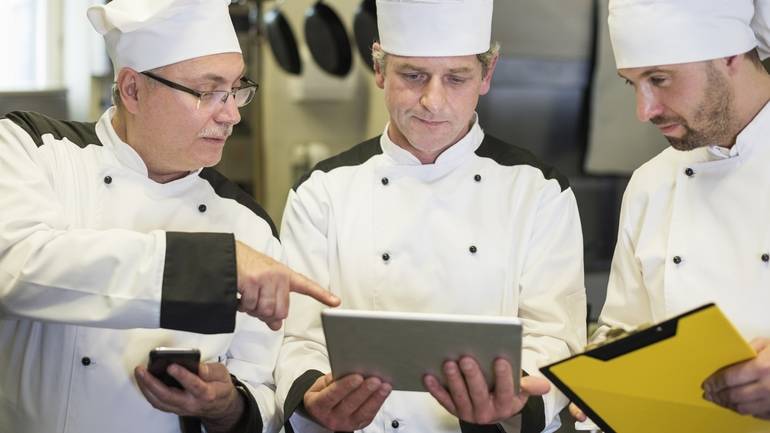
Hardware
Because of their different operating systems, TouchBistro and MICROS each use different POS hardware.
Oracle’s MICROS Tablets
In order to use the MICROS POS software, you’ll need to purchase Oracle’s proprietary MICROS restaurant POS hardware. There is a wide variety of Oracle hardware to choose from, including the brand’s flagship large-screen Workstation 8 Series display, and the mobile Tablet 700 Series device. Oracle even offers a Workstation 3 Series display ideal for venues with limited space and electrical outlets like food trucks.
For many restaurateurs, having a wide range of devices to choose from is a plus, because it allows them to fully customize their setup to suit their space. However, the downside of MICROS ’ strict hardware requirements is that you’re obligated to commit to these proprietary Oracle devices, instead of shopping around for less expensive tablets. It also means that if you decide you don’t want to use MICROS in the future, you’ll be stuck with some pricey hardware that won’t work with other POS systems – an issue you won’t have if you use more common devices such as iPads.
TouchBistro iPads
TouchBistro runs on iOS and uses iPads as the POS terminals. This means there’s no need to purchase proprietary hardware in order to use TouchBistro, and you may even be able to save money if you are switching from another iPad-based POS system (as long as the devices are a compatible generation).
Beyond cost, iPads are also incredibly easy to use. The user experience is the same across all Apple devices (e.g. iPhones and MacBooks), so any staff already familiar with these devices will easily be able to navigate the iPad interface. If you have a lot of front-of-house and back-of-house staff to train on your new restaurant POS system, opting for user-friendly hardware like iPads can make the training process significantly faster.
Add-On Solutions
In addition to core features, both TouchBistro and MICROS offer additional add-on solutions. These include everything from inventory management software to integrated payment processing.
| Payments | TouchBistro | MICROS |
| Payments Pricing Model | Fixed rate and interchange plus pricing | Varies based on payment processor |
Payments
In order to accept credit, debit, and digital payments, most restaurants work with a payment processing partner. To simplify things, most POS providers will offer POS-integrated payment processing as an add-on solution.
In the past, MICROS has worked with the payment processor Heartland Payment Systems to create an easy integration between credit card processing and the MICROS POS. However, MICROS doesn’t currently require the use of any one particular processor. This means that MICROS doesn’t currently require the use of any one particular processor, meaning customers have the freedom to choose from a wide variety of integrated payment processing partners.
In contrast, TouchBistro offers its own in-house payment processing solution called TouchBistro Payments. The benefits of using an in-house payment processor is that the POS speaks directly to the payment terminals, allowing for a seamless flow of data and eliminating the need for manual entry. This direct integration reduces the risk of order errors (and subsequent chargebacks), while also ensuring a quick and easy payment process for customers.
Not only does TouchBistro Payments offer a seamless payment processing solution with multiple use cases, but it also offers some of the most competitive rates on the market. This means you can rest easy knowing you won’t face any surprises on your monthly bill.
Other Add-On Solutions
Of course, restaurants have many other needs outside of payment processing, which is why most restaurant POS providers offer a wide range of other add-on solutions. Some common add-ons include inventory management, online ordering tools, reservations software, and more.
| Add-On Solutions | TouchBistro | MICROS |
| Integrated Payments | ✔ | ✘ |
| Inventory | ✔ | ✔ |
| Labor Management and Staff Scheduling | ✔ | ✔ |
| Online Ordering | ✔ | ✔ |
| Integrated Delivery | ✔ | ✔ |
| Reservations | ✔ | ✔ |
| Gift Cards | ✔ | ✔ |
| Loyalty and Customer Relationship Management | ✔ | ✔ |
| Marketing | ✔ | ✔ |
| Back Office Management | ✔ | ✔ |
| Self-Serve Kiosks | ✘ | ✔ |
| Kitchen Display System | ✔ | ✔ |
| Customer Facing Display | ✔ | ✔ |
| Digital Menu Board | ✘ | ✔ |
Both TouchBistro and MICROS offer many of the same add-on solutions, including:
- Inventory Management: A robust inventory and recipe management platform that helps restaurants keep a digital log of everything on hand, maximize recipes for profitability, and more.
- Labor Management & Staff Scheduling: An integrated team management solution that also allows you to create custom staff schedules.
- Reservations: A reservations management and waitlisting system that lets customers reserve tablets online and helps restaurants optimize their bookings.
- Online Ordering: A POS-integrated ordering system that gives customers the ability to place orders for pickup or delivery directly from a restaurant’s website and other online channels.
- Delivery: Restaurants can tap into a network of on-demand local drivers to get orders from door to door without lifting a finger.
- Gift Cards: Branded physical gift cards with multi-location reconciliation.
- Loyalty and CRM: An integrated CRM and rewards program that helps drive repeat visits.
- Marketing: A marketing solution that helps restaurants create and automate custom marketing campaigns.
- Profit and Back Office Management: Streamline operations with a back office solution that helps you manage inventory, invoicing, bill payments, and more.
- Kitchen Display System (KDS): A digital system for restaurant kitchens that displays orders in real time for the back-of-house staff.
- Customer Facing Display: A counter-service tablet system that faces the customer so they can visually confirm their order.
For the most part, TouchBistro and MICROS offer comparable add-on products. However, MICROS POS is an enterprise system, which means that it does have a few niche add-on functions that may be a benefit to major restaurant brands.
For instance, MICROS offers a unique online ordering solution for restaurants. MICROS has an open API, so you can work directly with MICROS to build the best online ordering system for your restaurant. This includes adding next-level features, such as a GPS-enabled web app, or location-aware technology to automate contactless pickup.
Though some of TouchBistro’s add-ons lack some of the bells and whistles that MICROSoffers, other solutions are more built-out than MICROS’.
For instance, TouchBistro Reservations is an end-to-end reservation system and guest management platform that integrates directly with your POS. Unlike MICROS’ own reservations system, TouchBistro Reservations allows guests to make online bookings through many different channels, including your restaurant’s website, Facebook page, or from the TouchBistro Dine platform. The TouchBistro Dine platform is especially valuable because it puts your restaurant in front of thousands of potential customers looking to book a table for their next meal – a major marketing advantage.

Compare the top legacy POS systems for restaurants on features, hardware, integrations, pricing, and more.
Integration Partners
In addition to add-ons, both TouchBistro and MICROS offer integrations with various third-party partners. This includes integrations for services such as accounting, delivery, advanced inventory management, and more.
| Integration Partners | TouchBistro | MICROS |
| Online Ordering and Delivery | ✔ | ✔ |
| Reservations | ✘ (in-house solution) | ✔ |
| Customer Relationship Management and Loyalty | ✘ (in-house solution) | ✔ |
| Staff Management, HR, and Payroll | ✔ | ✔ |
| Inventory Management | ✔ | ✔ |
| Accounting | ✔ | ✘ (in-house solution) |
| Reporting and Analytics | ✔ | ✔ |
When you compare TouchBistro vs MICROS head-to-head, you can see that both POS providers offer integrations for the following types of services:
- Online Ordering and Delivery Marketplaces: Sync multiple different third-party delivery apps with your POS system through online ordering aggregators.
- Staff Management, HR, and Payroll: Employee scheduling and complete labor management tools.
- Inventory Management: Advanced inventory management tools for both restaurants and bars.
- Reporting and Analytics: Advanced reporting tools that help to aggregate and simplify business data.
Though TouchBistro and MICROS may offer third-party integrations for similar types of services, there’s no question that MICROS comes out on top when it comes to the sheer number of third-party integrations available to its users. In fact, MICROS POS users have access to the Oracle Cloud Marketplace, which features hundreds of local and global partners that can help food and beverage businesses.
Of course, the reason MICROS offers such a large number of third-party integrations is because the MICROS POS is geared towards enterprise-level restaurant brands that often need to extend their POS capabilities to support their growing business operations.
In contrast, TouchBistro supports fewer third-party integrations than MICROS because it is geared towards independent restaurants, most of which have fairly straightforward needs that can be met with in-house solutions.
For anything not offered as an in-house solution, TouchBistro has a curated list of integration partners that includes industry-leading solutions that are already used by – or at least familiar to – most restaurateurs. For instance, TouchBistro supports Push Operations for payroll, DoorDash Drive for on-demand delivery, and leading tools like QuickBooks and Xero for accounting. As a result, most independent restaurants will be able to carry out just about any additional function they might need with their preferred software partner.
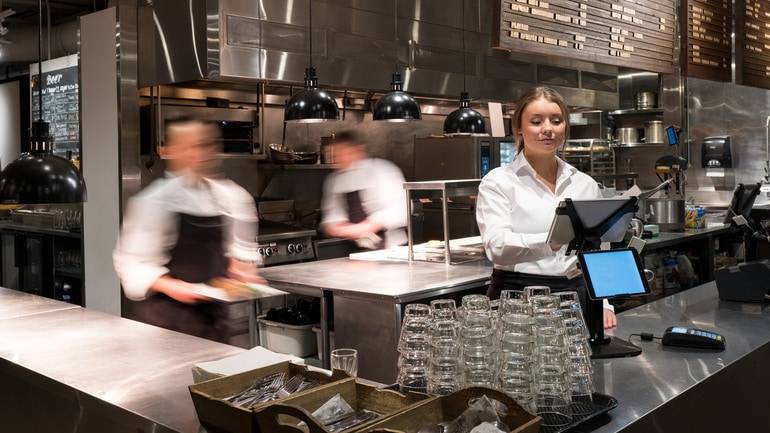
Pricing
No review of TouchBistro vs MICROS POS would be complete without a comparison of how much each system costs.
| Pricing | TouchBistro | MICROS |
| Software Pricing | Starting at $69 / month for a single license | Pricing only available with quote |
Unfortunately, it’s tough to say exactly how much the MICROS POS system will cost you because the company isn’t very transparent when its comes to pricing. Unlike most modern POS systems, MICROS does not make its pricing publicly available online. Instead, the company states that it’s POS systems are “are competitively priced” and encourages anyone interested to reach out for a custom quote – an extra hurdle to jump through that can be off-putting.
While MICROS promises a custom rate for each customer, you should expect these costs to be on the higher-end. MICROS is primarily designed for enterprise-level restaurants and that kind of feature-rich system often comes with a big price tag to match. Not to mention, you’ll also have to factor in the cost of purchasing MICROS’ proprietary hardware from Oracle.
In contrast, TouchBistro is much more transparent with its pricing. TouchBistro’s plans start at an affordable $69 USD per month for one license. TouchBistro also clarifies that all of its plans include its core POS features, cloud-based reporting and analytics, unlimited users, free integrations, and free 24/7/365 support.
To use the TouchBistro system, you’ll also have to factor in the cost of hardware. Fortunately, if you’re switching from another iPad-based POS, you can most likely reuse your existing iPads.
And if you don’t already own iPad tablets, a regular iPad will set you back around $300 to $400 for a brand-new device. While this may seem a little steep, this is actually significantly less than the cost of most legacy hardware. For comparison, the Oracle MICROS Compact Workstation 310 with 10.1-inch touchscreen display will cost you $1,299 USD per device.
Customer Support
Perhaps just as important as pricing, is the issue of customer support.
And when you compare TouchBistro vs MICROS on customer support, MICROS reviews suggest that the company often comes up short. Though the company boasts that customers “can count on 24/7/365 global support,” MICROS POS reviews note that the quality of support has suffered since the company was purchased by Oracle.
Even if its phone and email support is sometimes lacking, MICROS does offer fairly extensive online resources that can help with training or troubleshooting common issues. In fact, there is an entire My Oracle Support portal full of resources for MICROS customers.
On the other hand, TouchBistro shines when it comes to customer support. TouchBistro offers award-winning 24/7 customer service and technical support, 365 days of the year. TouchBistro’s support team can be reached by phone or email, and is largely staffed by former restaurant servers, owners, and managers. This means that when you call in, you’re usually speaking with someone who knows the industry inside and out, and has first-hand experience with all of the issues you’re experiencing.
For more minor issues, TouchBistro also has an extensive online resource library, complete with step-by-step guides and video tutorials. These guides are designed to help you troubleshoot issues quickly on your own so you can get right back to regular service.

Compare the top legacy POS systems for restaurants on features, hardware, integrations, pricing, and more.
TouchBistro vs MICROS POS: The Bottom Line
Having read a full review of TouchBistro vs MICROS, you’ve likely gathered that while the systems are comparable, each provider has specific strengths and weaknesses.
Overall, it’s clear that the MICROS POS is best for well established, global restaurant chains, such as Pizza Hut or Outback Steakhouse. MICROS not only has extensive POS features designed to support and manage multiple locations, but the system also supports multiple languages and currencies – something that’s essential to any global enterprise.
While MICROS is a great fit for global restaurant brands, TouchBistro is the better all-around solution for restaurants based on the following reasons:
1. User-Friendly Operating System and Hardware
If you’re going to go through all the trouble of setting up a new restaurant POS system, you want to make sure you choose one that your staff can learn quickly and use confidently on a daily basis. TouchBistro runs on an iOS operating system and uses Apple hardware, which is widely considered to be the most user-friendly option when it comes to POS software and hardware. Even if your staff are not familiar with Apple devices, the plug-and-play nature of TouchBistro means that training is straightforward and the system is intuitive enough for virtually anyone to understand.
Unlike TouchBistro, the MICROS POS runs on a Windows operating system and uses proprietary Oracle hardware, which comes with a much steeper learning curve. And when you combine this kind of system with MICROS’ vast array of features, it can make completing even the simplest daily tasks a lengthy process.
In other words, unless your staff have specifically used MICROS in the past, the system may not be the most user-friendly and may require more extensive training to get everyone up to speed – time that you don’t always have in a busy restaurant.
2. Reliable Customer Support
Few restaurateurs put great customer services at the top of their POS wish list, but they should. That’s because running a restaurant is a round-the-clock job and you need support to be there when things go wrong.
TouchBistro offers best-in-class support 24/7, 365 days of the year to make sure someone is always there when you need them. TouchBistro’s award winning customer service team is also made up of people with years of first-hand restaurant experience so the person on the other end actually understands what you’re dealing with and how to fix it.
While MICROS also offers 24/7/365 support, MICROS POS reviews suggest that actually getting a hold of support isn’t quite so simple. While some problems can certainly wait, lengthy call wait times can spell disaster if you’re dealing with major technological issues. And in the restaurant industry, a malfunctioning POS system could mean hundreds, if not thousands, in lost revenue.
3. Restaurant-Focused
If you run a tiny juice bar or coffee cart, you might be able to get by with a retail POS. However, if you’re running a full fledged restaurant, you need a dedicated restaurant POS system.
TouchBistro was designed by restaurant people, for restaurant people, to help make running your business easier and more profitable. This wealth of industry knowledge is the reason why TouchBistro’s core POS is equipped with features that are robust enough to support a wide variety of functions, but also intuitive enough for all your front-of-house and back-of-house staff to use.
With MICROS, you’re not getting a dedicated restaurant POS. MICROS is owned by Oracle, which makes POS systems for hotels, resorts, casinos, stadiums, airports, and more. This means when you go with MICROS, you’re not getting the focus of a company dedicated to the restaurant industry. Rather, you’re signing on with a major corporation that’s working on POS features for a vast array of businesses – many of which have wildly different needs than you.
While it’s clear there are plenty of similarities and differences between TouchBistro and MICROS, both are certainly great POS options for restaurants. Deciding which system is the better fit for your business simply comes down to your specific needs and the must-haves you can’t run your restaurant without. We hope that with this head-to-head review of TouchBistro vs MICROS POS, some of those must-haves are now a little easier to identify.
